
Photo: Praveen Chettr
The Bhutias or Denjongpas
The Denjongpas are the descendants of Tibetan settlers who came to Sikkim in several waves from 13th century onwards. The Tibetans call them Lhopos (people from the south); the Nepalese call them Bhotias (people from Bhot, Nepali for Tibet); but they are generally referred to as Bhutias or Denjongpas (inhabitants of Denjong, an old name for Sikkim).
The younger generation of Sikkimese Denjongpas have access to the latest technology, information and opportunities to fulfil their needs and wants. They prefer cell phones and apps to prayer wheels, choose pizza over tsampa (a traditional dish of roasted barley flour mixed with butter) and use Facebook for socializing and networking rather than meeting face to face.
Since becoming a state of India in 1975, with the transition in politics and power from a monarchic to a democratic system, Sikkim has been modernizing – willingly or otherwise. Like any other place in the world, the region has opened up to change, and is no longer “the hidden valley”. Increasing exposure to changing in geopolitical scenario in its neighbourhood is accompanied by recent developments in information technology and commerce sectors. This inevitable change is transforming Sikkim’s landscape and its people and raises cultural and environmental concerns.
The younger generation of Sikkimese Denjongpas have access to the latest technology, information and opportunities to fulfil their needs and wants. They prefer cell phones and apps to prayer wheels, choose pizza over tsampa (a traditional dish of roasted barley flour mixed with butter) and use Facebook for socializing and networking rather than meeting face to face. As one approaches the capital of Sikkim, billboards along the highway advertise various national and international clothing brands like Nike, United Colors of Benetton, Raymond, Adidas and so forth, besides displaying posters of newly released Hindi and English films playing in the city’s movie halls. On taxi rides in Gangtok one hears the latest Hindi, Nepali and English hip-hop numbers. In the main market on M.G. Marg are internet cafes with children and young monks surfing side by side. Concepts of development and modernity define the evolving cultural landscape in Sikkim around which the main industry – tourism revolves.
The Pho Kho for Men
The Denjongpas were generally very conservative in their dress before. Although some have taken to wearing Western clothes, traditional styles still prevail, especially amongst women. This traditional garment is called kho in Denjong kay (the Bhutia language) or bakhu in Nepali.
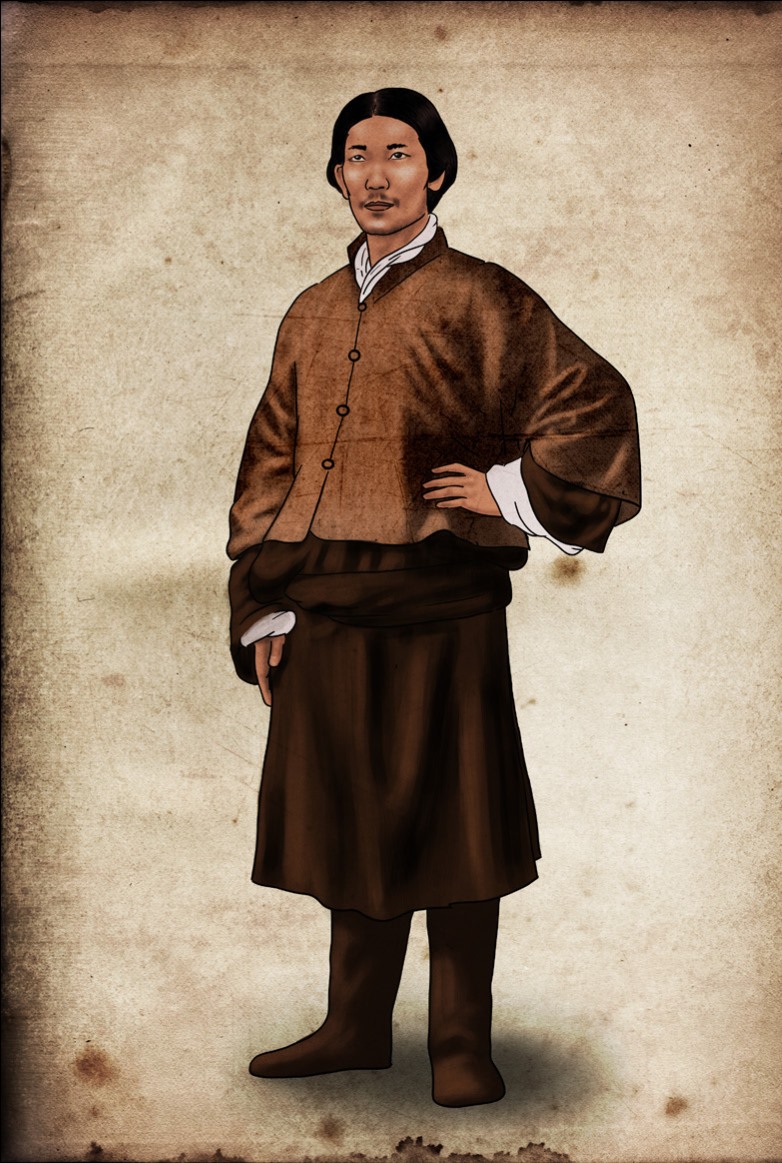
Illustration: Ranveer Singh Sahmbi, 2014.
Denjongpa men wear the pho kho or a full-sleeved garment tied at the waist with a silk kye rah (a girdle or belt). A variation of this, called puru kho or woollen gown, was worn by men in the high-altitude valley of Lachen and Lachung in North Sikkim. It normally consisted only of the kho, a long, capacious robe with wide, elongated sleeves which hung almost to the ground. The garment was folded from the sides on the back and caught at the waist by a woollen or silk kye rah, so that its skirt reached only to the knees and its upper folds formed an enormous circular pocket or amba over the chest. A wide range of items – an eating bowl, a bag of tsampa and other small necessities were stowed in it.

Photo: Praveen Chettri
The town-dwelling Denjongpa noblemen, for the most part, supplemented this garment with cotton or woollen drawers and a cotton or silk full-sleeved undershirt. This traditional shirt called wonthatsi, is usually white and the extra-long sleeves previously symbolized that the nobility wearing it do no manual work. The wonthatsi is worn underneath the kho.
The Kho is accompanied by a jaja or a waistcoat made from Chinese brocaded fabric, decorated with dragon design, tankas (Chinese coin designs), khorlos (wheel of dharma or dharma chakra in Tibetan) or other traditional Buddhist motifs. Earlier only members of the nobility or village headmen wore the waistcoats on special occasions; today it is worn by everyone in every occasion. On special occasions like marriages men wear thuril shambu or chingsha, two varieties of hats made of yak wool.
The traditional attire is completed by the pho som (also known as tsompa), handstitched boots decorated by brocade or embroidered on woollen cloth, with soles made by raw untanned animal hide. The boots are loose-fitting and have brightly coloured woollen or cloth garters around the tops that fasten to the legs below the knee. The shoes are black, red or green. Previously shoes were worn only by the nobility in Sikkim. Their feet would be bare inside these great high boots. The lhol ham is another kind of shoe which is supposed to be typical of the Lachen-Lachung valleys, The variety is made of sheep wool with a sole of well-tanned yak hide.
The Mo Kho of Women
The mo kho , a sleeveless garment tied at the waist by a kye rah, can be made from any material available; the rich used Chinese brocade. The mo kho is loose fitting, full length folded from the sides and held in place by a girdle. Just as in the male kho, in front of the garment there is a fold of cloth in which various items can be stored. A full-sleeved buttonless blouse called teygho is worn inside the kho. This is made of thin fabric, usually silk and now polyester, though cotton may also be used. The ku shen or the outer coat worn on top of the kho is often made of brocade, raw silk or synthetic fabric.
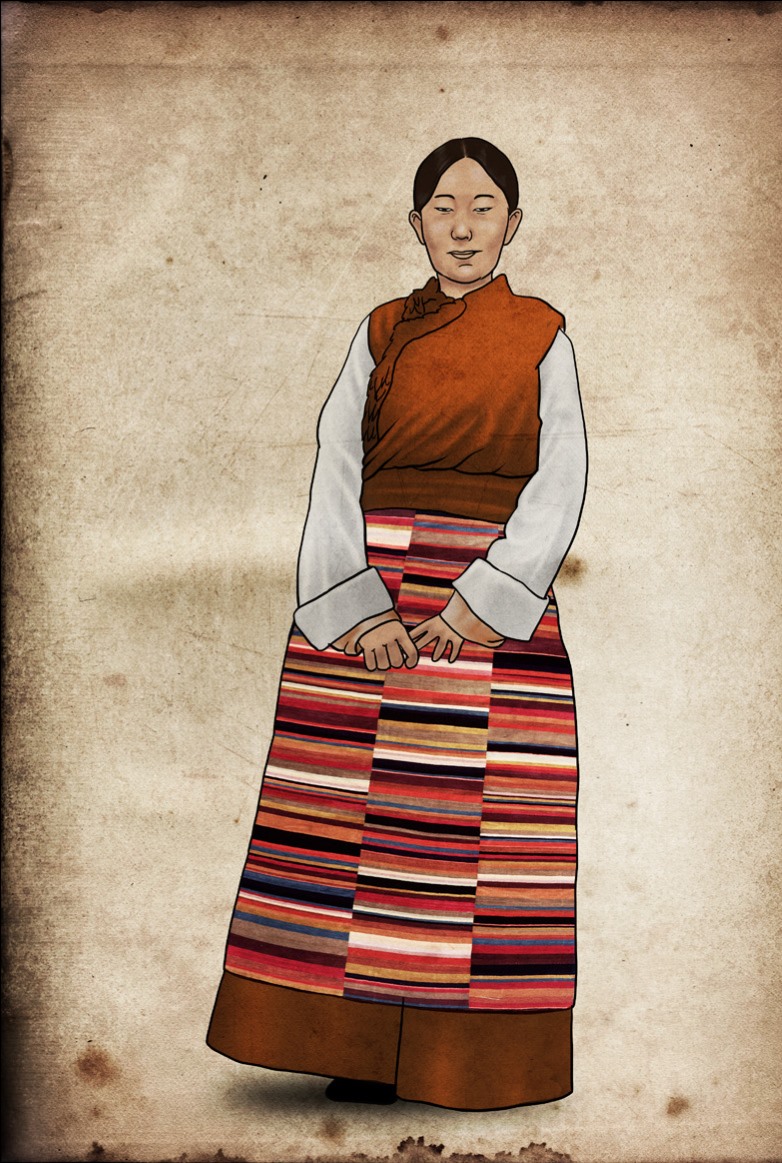
Illustration: Ranveer Singh Sahmbi,2014.
On special occasions, women of East, South and West Sikkim wear a long-eared hat made from silk fabric with a fur border – the tshering kinkhap, also called siling shambu. It may be made of silk brocade with fur lined flaps that can be lowered against the mountain wind. The women of Lachung and Lachen valleys wear such hats with shorter ears called the mogril namchochen or also tsehring kinkhap. Motsompa or boot like shoes made from cotton or woollen cloth with soles of tanned animal skin are mostly worn by women here. In contrast to the plain design of the male shoes the female ones are embroidered with floral design.

Photo: Praveen Chettri
The gyapa or gyab bag is hand-woven rain cloak made from sheep or yak wool, fastened over the chest with a hook called chahuk (made of silver with floral designs engraved on it). The people of Lachen and Lachung – Lachenpas and Lachungpas – use the gyapa to protect themselves from rain, snow and cold. A married woman wears a pangden or a colourful striped apron around the waist, over the kho. This was traditionally hand-woven on backstrap loom. Today pangdens are also made of hand woven multicoloured silk fastened with pangtha or straps.
During marriage ceremonies, the bride partially covers her face with a khatee, a red scarf, hand-woven from raw silk or cotton, with colourful embroidered designs and fringes at both ends. Another piece of embroidered satin, the kinkhap, is used by noble ladies in Sikkim to cover the neck before putting on necklaces.
Religious Garments of Sikkimese Monks
The monks or lamas have their own attire. They wear a lower garment called shenthap, made of cotton or woollen fabric, usually maroon in colour. The khenjah is a sleeveless shirt, orange or yellow in colour, made from cotton or silk. During a religious ceremony or while entering the monastery or sacred places of worship monks drape a dzen, a long ceremonial shawl made of raw silk, woollen fabric or cotton.

Photo: Praveen Chettri
There are several types of coats worn by monks of different status and adapted to climate conditions. High Lamas wear the toenga, a sleeveless woollen coat, decorated with brocade (usually red). The dagam is another religious cloak made of woollen fabric, which a High Lama wears hanging from the shoulders. This cloak originally had an inner lining of fleece with woollen outer lining. It is often worn as winter cloak. Hermits or tshanpas living at a higher altitude wear a tombo, a buttonless full-sleeved coat made from any fabric with fur lining.
The peh sha (pad shwa ) is a kind of mitre-shaped cap that originated from the religious cap worn by Guru Padmasambhava, one of the founding fathers of Tibetan Buddhism. He appeared in Tibet in 749 CE and spent 54 years there. Peh sha is normally worn by the incarnate lama or the Head Lama of the monastery belonging to the Nyingmapa or Kagudpa sects of Buddhism. The other monks in the monastery wear a conical mitre-shaped cap called the pan sha tse sing.

Photo : Praveen Chettri
There is an interesting story about the origin of the pan sha cap. In the Padma Vihara (monastery) of Chittagong (present day Bangladesh), some heretic teachers challenged a Buddhist Pandit (priest) in a religious debate. The pandit, as advised by an old woman, wore an unusual cap pointed like a thorn while debating religious ethics, and eventually defeated his opponents. As a result of his victory, the use of this cap became popular and later Tibetan and Sikkimese monks adopted the fashion.
There is a specific kind of shoe, called rey som, which does not belong to the monks’ everyday attire, but is only used by the masked dancers in monasteries in Sikkim on special occasions. These shoes are made from cotton fabric and are imported from Tibet and Bhutan.
From Handmade to Factory-Produced: Transformation of the Kho
The Denjong kho has evolved over the 370-odd years since the formation of the kingdom of Sikkim in 1642. The traditional hand-woven fabrics and tanned yak skins are today replaced by factory produced materials. Between 1700s and the 1800s, Denjongpa men and women wore the kho made of sheep or yak skin and wool. When trade opened up between India and Tibet other factory manufactured materials became available.
The Denjong kho has evolved over the 370-odd years since the formation of the kingdom of Sikkim in 1642. The traditional hand-woven fabrics and tanned yak skins are today replaced by factory produced materials. Between 1700s and the 1800s, Denjongpa men and women wore the kho made of sheep or yak skin and wool. When trade opened up between India and Tibet other factory manufactured materials became available.

Photo: Kunga Tashi Lepcha
Tibetan traders used to bring both the materials as well as ready-made garments into Sikkim through the historic trading town of Yatung in Tibet. In contrast, the Lachenpas and Lachungpas, who lived in very harsh climatic conditions, generally wore sheep-skin robes, hand-sewn and crudely tanned in butter, with the fleece on the inside. In most cases, the kho used to be glued together with animal and gelatine instead of stitching it.
By the early 1900s, with frequent trade between Sikkim and India, there were better and cheaper variations of woollen and cotton fabric available. Textiles were chiefly brought in by the Agarwal Trading Company (Marwari traders) to Kalimpong, an important trading centre of trade between India, Sikkim, Nepal, Bhutan, Tibet and China. After the Chinese invasion of Tibet in 1959, a large number of Tibetan refugees settled in Sikkim. Among them were a group o f highly skilled tailors, both men and women, from different parts of Tibet, called ulah.
The kho was slowly transformed over time, as stitching became more common and alternative fabrics used. These transformations diminished the differences between the ways of dressing among commoners and the nobility, and led to a style common to all Denjongpas regardless of social background.
In the mid-1940s the female kho was fundamentally changed. Princess Coocoola (Princess Pema Tsedeun Yapshi Pheunkhang Lachum Kusho), who died in 2008 at the age of 84, played a major role in redesigning the Denjong kho, adapting it to meet the modern requirements. She was the daughter of Sir Tashi Namgyal, the 11th Chogyal, married to a Tibetan Governor of Gyantse.
The female kho used to be loose fitting gown fastened by a separate belt. In its new design, the upper part of the dress is tailored to closely fit the body. Handbags replaced the traditional mode of carrying items within the folds of the kho. From the waist down the gown opens up into wide flaps on both sides At the ends of the flaps are straps made of the same material as the kho. The flaps are folded back while the straps maybe tied at the back or straps go round the waist and tied together in a bow or a knot. Depending on the preference and style, the straps maybe tied at the back or on the side. In this way, the kho still keeps the effect of being loose and folded at the lower section, while being fitted above. The outfit was further adapted and made sleeveless, though full length sleeves are still worn. This outer garment was often made from plum silk brocade woven in gold with Tibetan motifs of longevity. Depending on the occasion, subtler materials are used. The kho is worn over the teygho or blouse.
The redesigned kho is easy to wear, lighter and elegant. Young Denjongpa women have readily adopted it; in fact, this kho design is so popular it has spread to adjoining regions as well. Besides being worn by the Tibetan refugees in India, the design has also been adopted in Tibet and is now considered the “traditional dress” of Tibetan women.
Modernity Fashion and the Position of the Kho
The great changes in Sikkim over the past century initiated social transformation and altered Sikkimese perceptions of their own place and culture. The Western system of education was adopted, this included the introduction of uniforms in schools. Furthermore, students were encouraged to connect with the external world to build a modern Sikkimese society. The state sent many students to study outside Sikkim to schools with English medium of instruction. This crucially affected the way people dressed and behaved in society. The Denjongpas, however, still largely followed a disciplined dress code under the guidance of the Chogyal, and the notion of national dress prevailed.
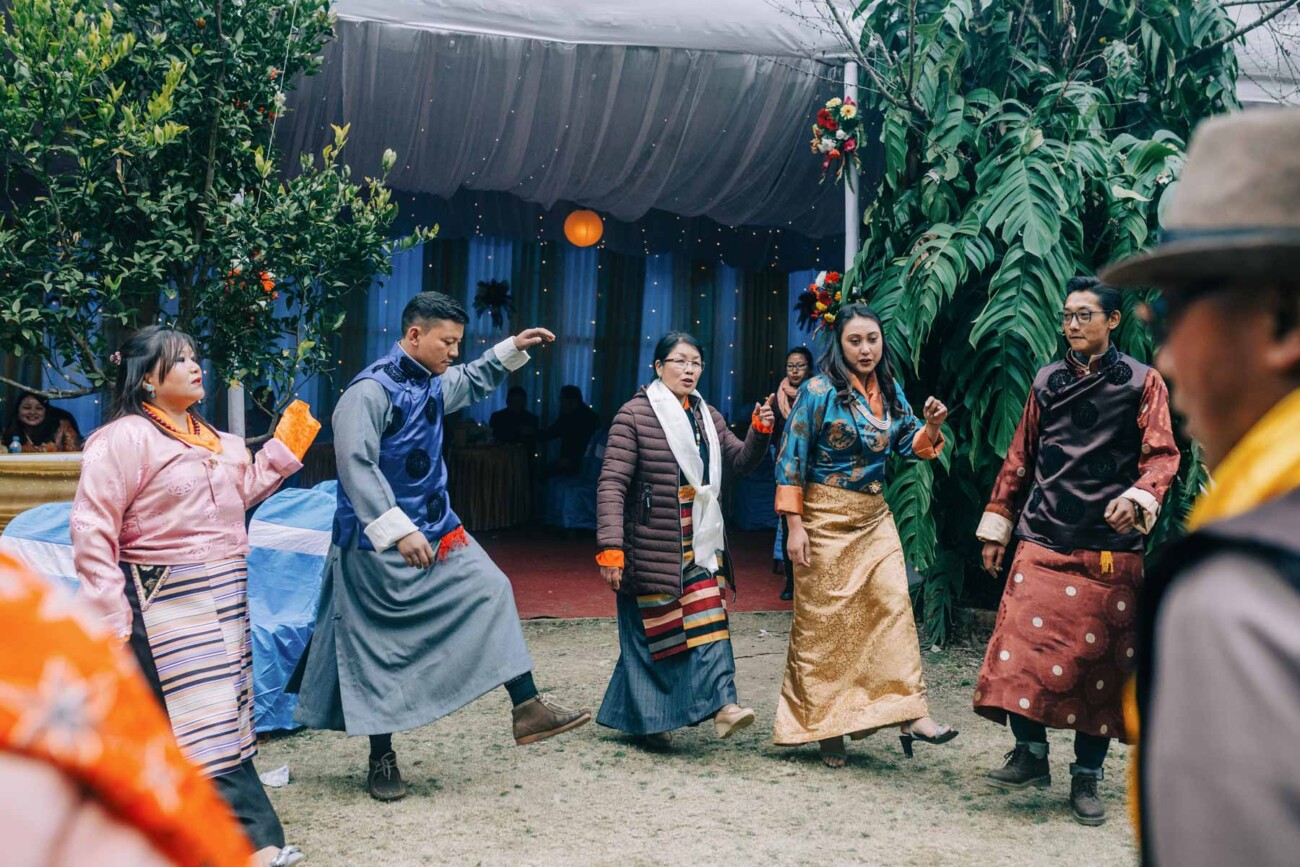
Photo: Praveen Chettri
Today the kho is predominantly worn on festivals like Losung (Sikkimese New Year). Both men and women wear traditional clothing for weddings, funerals and special religious events. For men, traditional occasions are the only times they take out their kho. Denjongpa married women continue to wear the kho on daily basis as many of them believe this dress gives them a sense of dignity, while younger women wear the kho because they find the idea of ethnic design and fabric fashionable. The availability of a wide range of materials in varied colours and prints makes it even more appealing. Further, while both young and old generations of Denjongpas agree that modern Western-style of clothing is more suitable for everyday wear in the Sikkimese context many working women – especially those in government jobs or visiting government offices on official errands – choose to wear the kho.
However, Western-style clothing is fast becoming dominant, with more clothing shops and branded retail outlets in Sikkim catering to their requirements. One’s choice of clothing style may reflect one’s attitude towards tradition and modernity. In this context, the word “modern” not only relates to clothing, but also the way Denjongpas live today. The Denjongpas traditionally settled in deep valleys and lived in houses they built themselves. Their houses were constructed of earth, stone and wood. This traditional architecture was surrounded by an ecosystem, and culture that were preserved by the community.
Over the years, the community has moved away from its traditional architecture and to settlements in cities, living in buildings built by migrant labourers from Bihar and Bengal. One of the many limitations of living in these buildings is the lack of space for drying clothes, besides the rationed, erratic water supply to wash them. These could be among the reasons why it became convenient to adopt new style of clothing. However, the availability of dry-cleaning facilities, and later the introduction of washing machines, are important factors encouraging women to wear the kho on daily basis.
Rapid centralized developments in the capital Gangtok were mainly responsible for changes in other parts of Sikkim. From the 1970s, the population, especially the educated and the business classes started migrating to Gangtok from other parts of Sikkim to seek a “modern life” – defined by increased job opportunities and better infrastructure facilities compared to other districts. The growing influence by the audio-visual media, radio, cinema and television brought in new trends in music, dress, hairstyles and attitudes amongst the Denjongpas. More recently, the mobile phone has provided a revolutionary tool of communication. Accessible to most income groups, it has become a status symbol.
It is true that there is a conflict between tradition and modernity when we examine the life of the Denjongpas. People now interpret the satisfaction and fulfilment of material needs of food, clothing and shelter in different ways. The Denjongpas relied on agriculture and animal husbandry to meet their subsistence needs for many centuries, but this has changed. With the increase in tourism in Sikkim and job opportunities outside the state they, like other communities in Sikkim, have learned many new ideas/skill through interaction with other ethnic groups and cultures or simply through modern education. The Denjongpas have also realized that their lives are dependent on other people and on the market more than before.
The modern day Denjongpa accepts this as a natural transition reflective of a culture receptive to growth, change and learning, while being conscious of the need to take the best of it. Today, the Denjong kho is more a symbol of ethnic identity and even a fashion statement, rather than merely an item of clothing in the conventional sense.
PHOTO GALLERY
(CLICK TO ENLARGE)
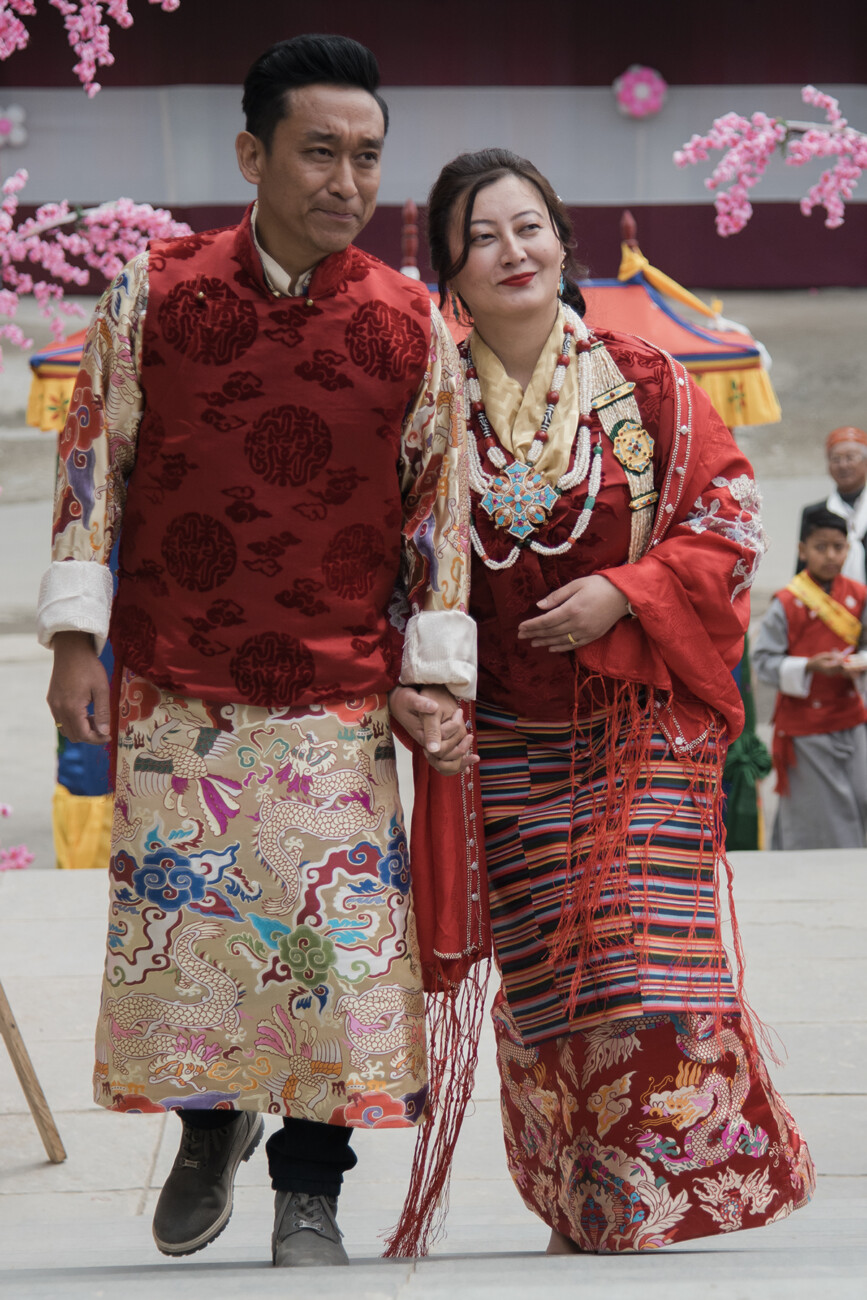
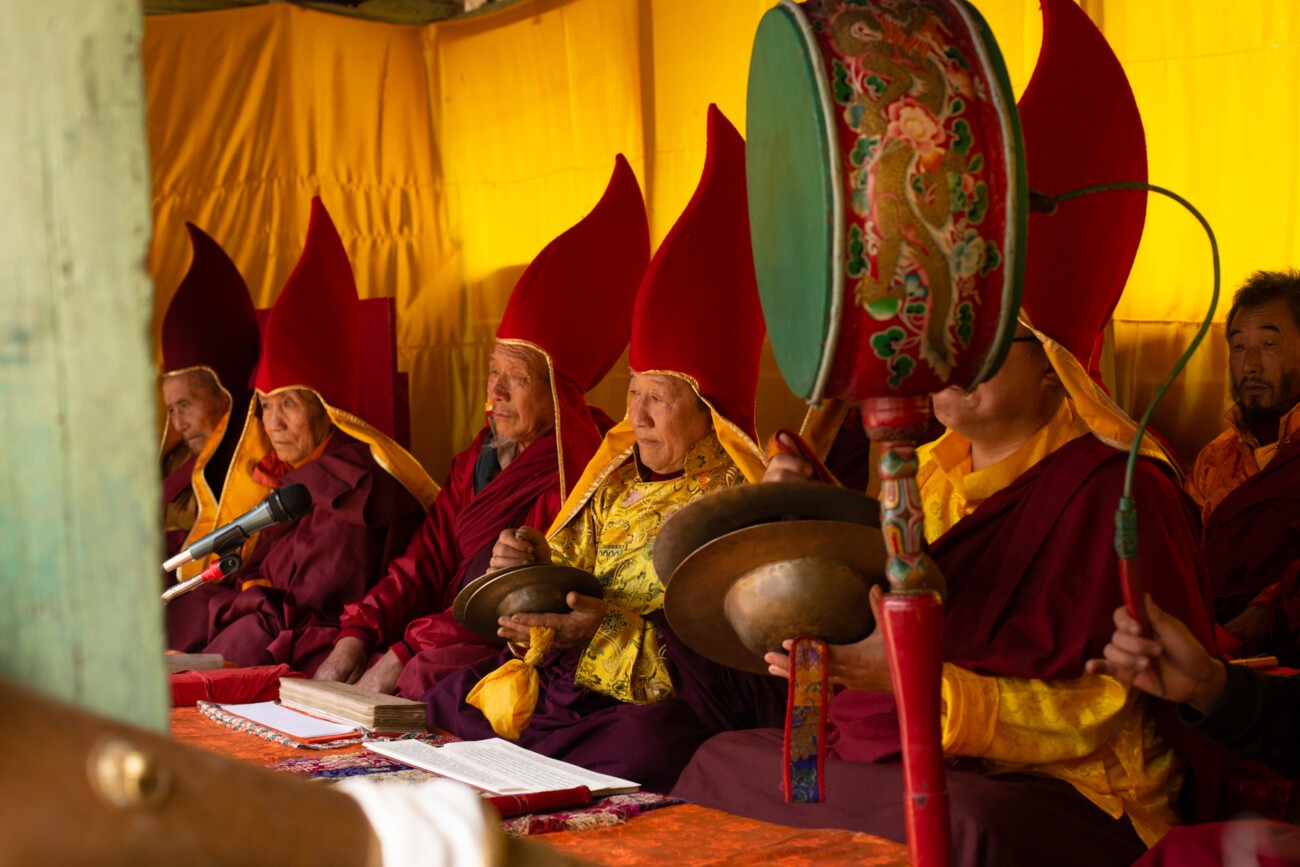
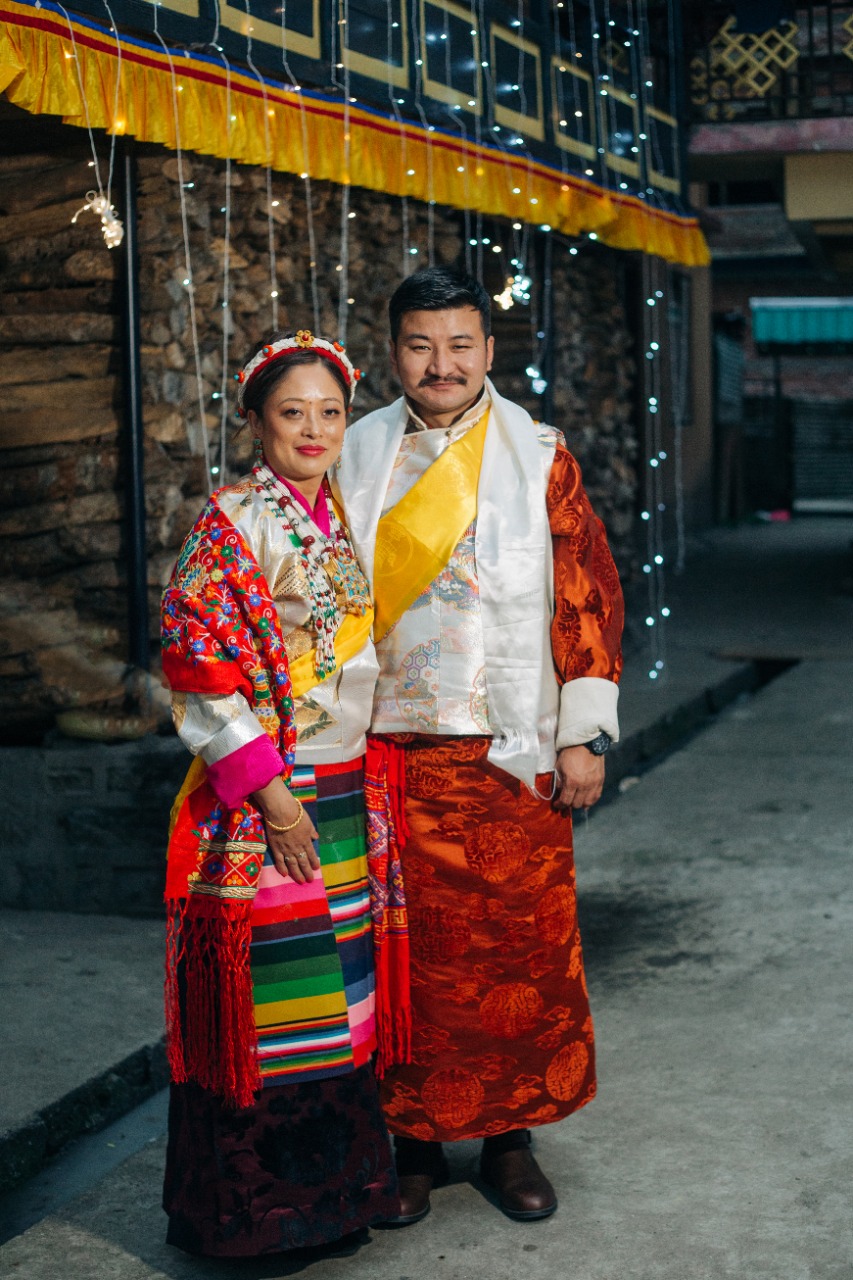


Reference:
Dokhampa, S.G. “Losoong Festival , Chapter III, Gangtok: self-published booklet.
- Reprinted with permission from MARG, Mumbai (Sikkim: The Reinvention of Identities and Cultures edited by Prava Rai) MARG Vol.65 No:4 2014
Sonam Tashi Gyaltsen is an Industrial Design graduate from the National Institute of Design, Ahmedabad. He is Co-founder of a multidisciplinary design studio called Echostream and a sustainable social enterprise called La. The studio focuses on community-driven design solutions. He is a recipient of the Naturenomics Award 2021.Echostream has worked with 20 sectors so far in Sikkim. Collaborations so far have been with students, entrepreneurs, designers, markets, communities, government institutions, and environmental stakeholders. Echostream focuses on local issues.


I knew quite a bit about Sikkimese traditions, but this read was even more informative. I loved learning the new details.
Thank you for your hard work.